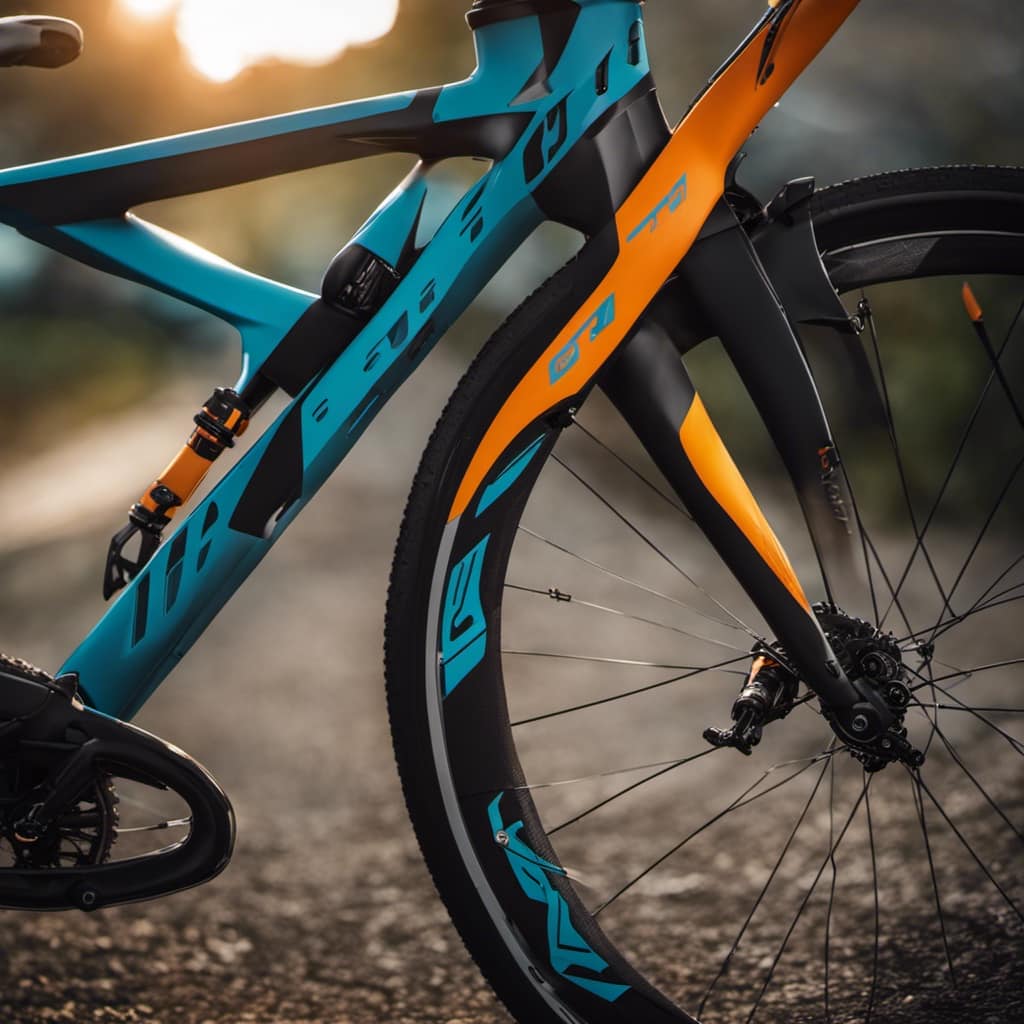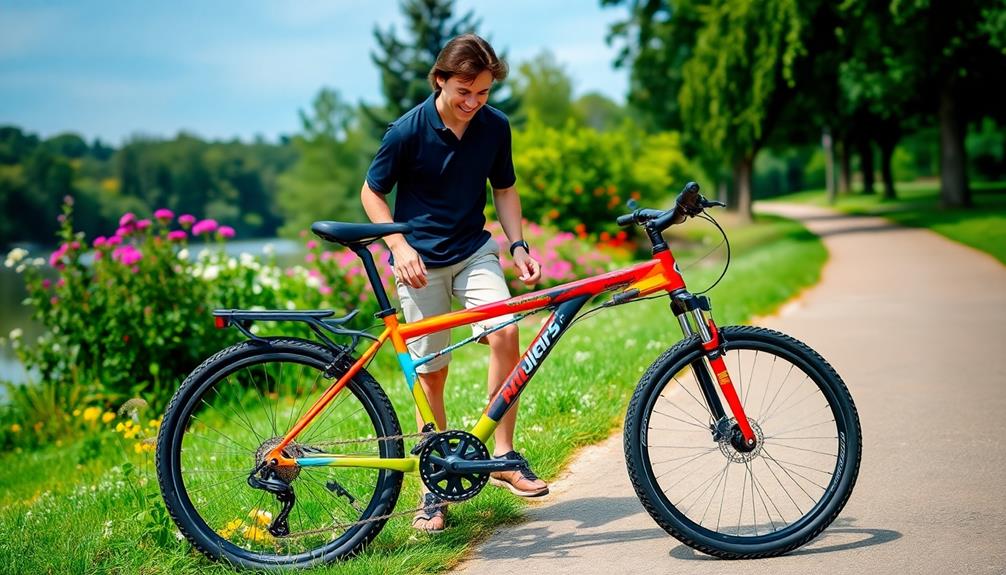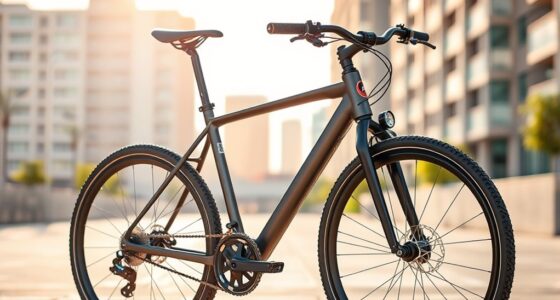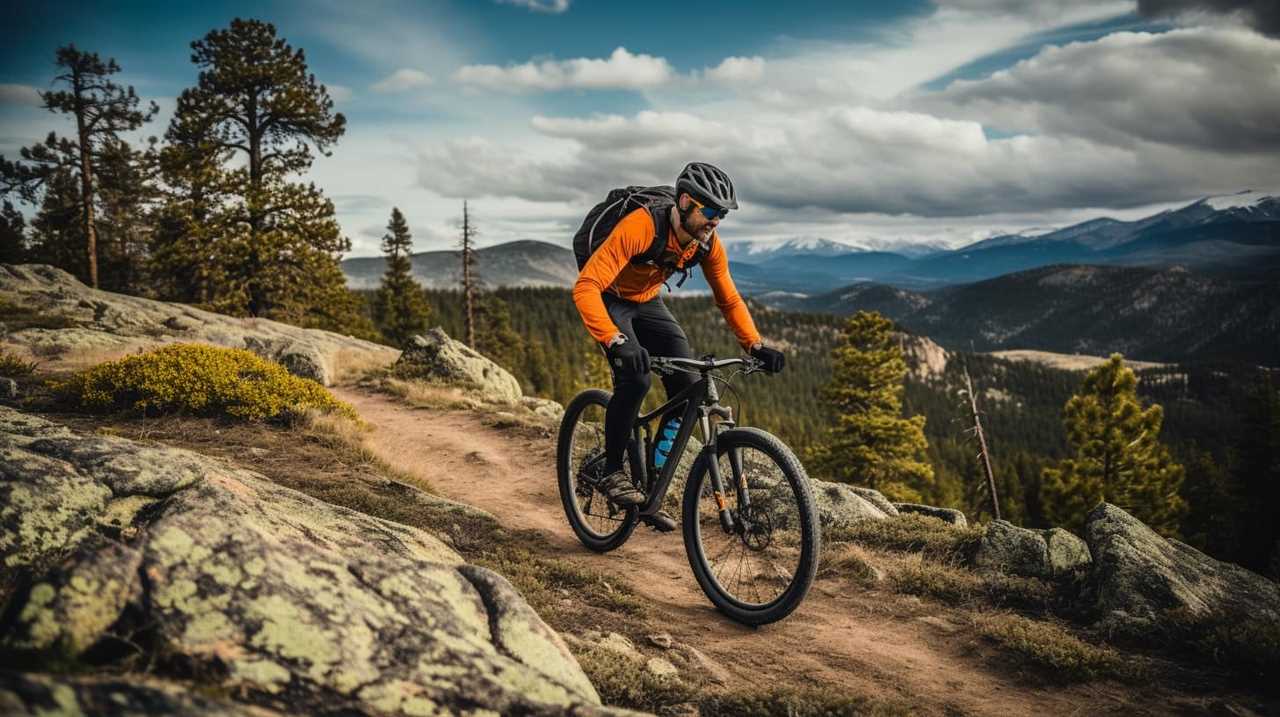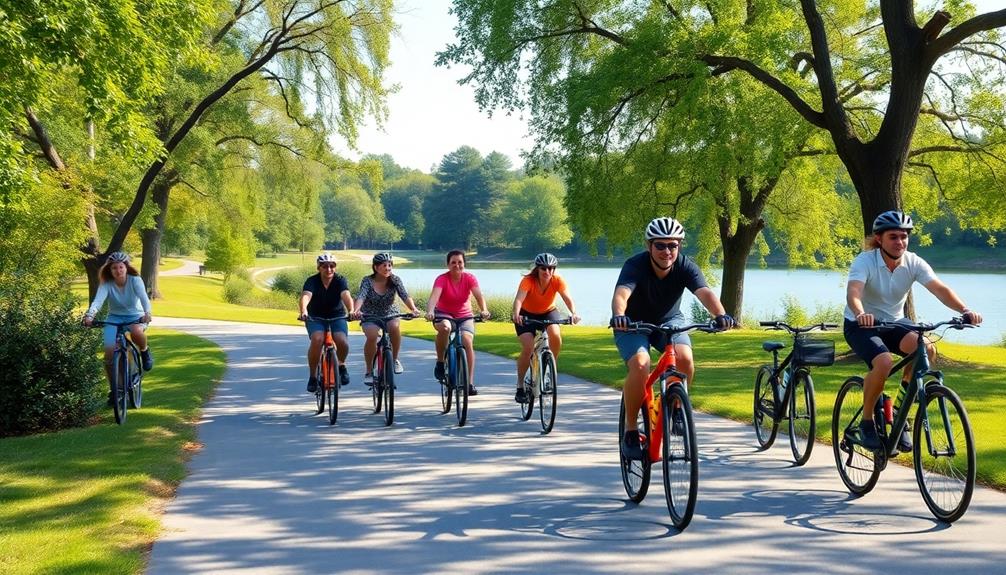Are you ready to take your hybrid bike riding to the next level?
We’ve got you covered with our 12 essential tips for efficient techniques.
From finding the right bike frame size to mastering gear utilization, we’ll help you ride with confidence and skill.
Whether you’re a beginner or an experienced rider, our tips will have you pedaling like a pro in no time.
Get ready to elevate your hybrid bike riding game and experience the freedom of the open road.
Key Takeaways
- Choosing the right bike frame size and material is crucial for comfort and efficiency.
- Proper gear utilization and smooth gear transitions help maintain momentum and prevent chain slippage.
- Utilizing proper pedaling technique and maintaining a consistent cadence improves efficiency.
- Mastering braking, balancing, and handling techniques ensures safety and smooth handling on hybrid bikes.
Choosing the Right Bike Frame Size
We should start by considering the right bike frame size for us.
When it comes to choosing the perfect bike frame, two important factors to consider are the bike frame material and the bike frame geometry. The bike frame material can greatly affect the overall weight of the bike, as well as its durability and ride quality. Common bike frame materials include aluminum, steel, carbon fiber, and titanium.
On the other hand, bike frame geometry refers to the angles and measurements that determine how the bike fits and handles. It affects factors such as stability, comfort, and maneuverability. Finding the right bike frame size and geometry is crucial for a comfortable and efficient ride.
Now that we’ve the right bike frame size, let’s move on to discussing the proper bike saddle height.
Proper Bike Saddle Height
Finding the optimal bike saddle height is crucial for ensuring a comfortable and efficient riding experience. Proper bike saddle height not only improves bike saddle comfort but also helps prevent injuries and maximizes power transfer. Adjusting saddle height is a simple process that can greatly enhance your overall cycling experience.
To determine the correct saddle height, follow these steps:
- Sit on your bike with your heels on the pedals in a horizontal position.
- Rotate the pedals backwards until one leg is fully extended.
- If your heel can touch the pedal without straining your leg, your saddle height is correct.
- If your leg isn’t fully extended, adjust the saddle height accordingly.
Correct Handlebar Positioning
To achieve proper handlebar positioning on your hybrid bike, adjust both the height and angle of the handlebars to ensure a comfortable and efficient riding experience. Bike handlebar adjustment is crucial for maintaining control and reducing fatigue during long rides.
Start by adjusting the height of the handlebars. A general rule of thumb is to position them at the same level as your saddle or slightly higher. This allows for a more upright riding position, reducing strain on your back and neck.
Next, focus on the angle of the handlebars. Experiment with different angles to find the most comfortable position for your hands. Some cyclists prefer a slight upward tilt, while others prefer a flat or slightly downward tilt. By finding the right balance, you can optimize your hand positioning techniques and enhance your overall riding experience.
Now that you have achieved the correct handlebar positioning, let’s move on to mastering shifting gears.
Mastering Shifting Gears
Now let’s talk about mastering shifting gears on your hybrid bike.
When it comes to gear optimization techniques, it’s important to understand the different gear ratios and how they can affect your speed and effort.
Smooth gear transitions are also crucial for maintaining momentum and preventing chain slippage.
We’ll provide you with some valuable tips to help you become a pro at shifting gears efficiently.
Gear Optimization Techniques
As we ride our hybrid bikes, we must focus on mastering the technique of shifting gears for optimal performance. Gear optimization plays a crucial role in ensuring a smooth and efficient ride.
When it comes to gear selection, it’s important to choose the right gear based on the terrain and your pedaling cadence. Shifting gears at the right time is key to maintaining a steady pace and conserving energy.
As you approach inclines or steep hills, shift to a lower gear to make pedaling easier. On the other hand, when riding downhill or on flat roads, shift to a higher gear to increase speed and efficiency.
Practice shifting gears regularly to get comfortable with the process and ensure a seamless riding experience. With proper gear optimization techniques, you’ll be able to conquer any terrain with ease.
Smooth Gear Transitions
We can achieve smooth gear transitions by practicing our shifting technique and using the correct gear combination for each situation. Here are some tips to help you master shifting gears on your hybrid bike:
- Anticipate the terrain: Shift into a lower gear before approaching a hill or incline to maintain a steady cadence and prevent strain on your muscles.
- Feather the shifters: Instead of forcefully pushing or pulling the shifters, apply gentle pressure to smoothly transition between gears.
- Avoid cross-chaining: Cross-chaining occurs when you use extreme gear combinations, such as the largest chainring and the largest rear cog, or the smallest chainring and the smallest rear cog. This can cause excessive chain wear and inefficient pedaling.
By practicing these techniques, you’ll be able to smoothly shift gears and maintain efficient pedaling throughout your rides.
Transitioning into the next section, let’s now discuss the importance of efficient pedaling technique.
Efficient Pedaling Technique
We can improve our efficiency on a hybrid bike by focusing on proper positioning and utilizing the correct gear for pedaling.
One key aspect of efficient pedaling technique is pedal efficiency. This refers to the ability to transfer power smoothly and effectively from your legs to the bike. To achieve pedal efficiency, it’s important to maintain a consistent cadence, or pedal speed. This means finding a rhythm that feels comfortable and allows you to generate power without straining your muscles.
It’s also crucial to avoid mashing on the pedals, as this can lead to wasted energy and fatigue. Instead, focus on a smooth and fluid pedaling motion, applying force evenly throughout the entire pedal stroke.
Braking Techniques for Hybrid Bikes
To ensure safe and effective braking on our hybrid bikes, we need to be familiar with the proper techniques for utilizing both the front and rear brakes. Here are some essential tips to help you master braking on your hybrid bike:
-
Apply both brakes evenly: When braking, it’s important to engage both the front and rear brakes simultaneously. This helps distribute the braking force evenly and prevents the bike from skidding.
-
Practice emergency braking: Emergency situations can arise while riding, so it’s crucial to be prepared. Practice emergency braking by squeezing both brakes firmly but gradually to slow down quickly without losing control.
-
Avoid skidding: Skidding can be dangerous and cause loss of control. To avoid skidding, apply the brakes with a gradual and controlled pressure rather than slamming them on. This allows the tires to maintain traction with the road surface.
Balancing and Handling the Bike
When it comes to balancing and handling a hybrid bike, there are a few key points to keep in mind.
First, maintaining the correct body posture is essential for balance and stability.
Second, mastering steering and maneuvering techniques will allow for smooth and controlled handling of the bike.
Lastly, understanding how to distribute your weight properly will help maintain control and prevent accidents.
Body Posture for Balance
Our body posture plays a crucial role in maintaining balance and effectively handling the bike while riding. To achieve optimal balance, it’s important to focus on core strength and weight distribution.
Here are some tips to help you maintain the right body posture while riding:
-
Keep your core engaged: By activating your core muscles, you create a stable and strong center of gravity, which helps in maintaining balance on the bike.
-
Distribute your weight evenly: Shift your weight between your pedals, saddle, and handlebars to distribute your weight evenly across the bike. This will ensure stability and control.
-
Relax your upper body: Avoid tensing up your shoulders and arms. Instead, keep them relaxed and loose, allowing for better maneuverability and responsiveness.
Steering and Maneuvering Techniques
We frequently practice steering and maneuvering techniques to effectively balance and handle our bike while riding. When it comes to cornering, it’s essential to lean into the turn and shift our body weight towards the inside of the curve. This helps us maintain stability and control while navigating corners at higher speeds.
Additionally, we need to be mindful of avoiding obstacles on the road. By scanning the path ahead and anticipating any potential hazards, we can make quick adjustments to our steering and avoid collisions. It’s important to remember that smooth and gradual movements are key to maintaining balance and control.
With these cornering techniques and obstacle avoidance skills, we can confidently navigate various terrains and enjoy a safe and liberating riding experience. Speaking of safety, let’s now discuss the importance of tire pressure in the next section.
Importance of Tire Pressure
Maintaining the proper tire pressure is crucial for optimal performance and safety while riding our hybrid bikes.
Here are some reasons why tire pressure is important:
-
Advantages of tubeless tires: Tubeless tires have become increasingly popular due to their ability to resist punctures and offer a smoother ride. By maintaining the correct tire pressure, we can maximize the benefits of tubeless tires and ensure a comfortable ride.
-
Optimal tire pressure for different terrains: The ideal tire pressure varies depending on the terrain we’re riding on. For rough and rocky terrains, lower tire pressure provides better traction and shock absorption. On smoother surfaces, higher tire pressure allows for faster and more efficient riding.
-
Enhanced control and stability: Proper tire pressure ensures better control and stability while riding, especially when cornering or maneuvering through challenging terrains. It helps prevent skidding and improves overall handling.
Maintaining the right tire pressure is just the first step towards a successful ride. Now, let’s explore the techniques for riding in different terrains.
Riding in Different Terrains
When riding in different terrains, we need to be prepared for various challenges. Uphill techniques are essential for maintaining momentum and conserving energy.
Downhill control is important to ensure safety and avoid accidents.
Additionally, handling rough surfaces requires a combination of balance, skill, and proper bike handling techniques.
Uphill Techniques
Our uphill technique involves using the appropriate gear and maintaining a steady pedal cadence. When it comes to uphill climbing on a hybrid bike, here are some essential tips to help you conquer those challenging terrains:
-
Choose the right gear: Shift to a lower gear before you start climbing to maintain momentum and prevent strain on your muscles.
-
Maintain a steady pedal cadence: Aim for a consistent rhythm while pedaling uphill. This will help you distribute the effort evenly and keep your momentum going.
-
Stay seated and relaxed: Avoid standing up on the pedals unless necessary. Instead, stay seated and focus on maintaining a relaxed upper body posture, allowing you to conserve energy.
Downhill Control
Let’s talk about how we can maintain control while riding downhill in different terrains on our hybrid bikes.
Downhill riding can be exhilarating, but it’s important to prioritize our safety by mastering bike control and speed management.
To maintain control, it’s crucial to have a balanced body position. Keep your weight centered over the bike, with your knees slightly bent and elbows relaxed. This will help you absorb any bumps or obstacles you encounter along the way.
Additionally, it’s essential to anticipate and adjust your speed accordingly. Feathering the brakes, using both the front and rear brakes in a controlled manner, can help you maintain a steady pace while descending.
Remember, practice makes perfect, so take the time to familiarize yourself with the techniques and build confidence in your downhill riding skills.
Enjoy the thrill, but always prioritize safety and control.
Handling Rough Surfaces
We can enhance our riding experience by mastering the techniques for handling rough surfaces in different terrains on our hybrid bikes. When it comes to handling corners on rough surfaces, it’s important to maintain traction and control. Here are some tips to help you navigate these challenging terrains:
- Slow down before entering the corner to maintain better control
- Shift your body weight towards the outside of the corner to improve stability
- Keep your eyes focused on the exit of the corner to anticipate any obstacles
Maintaining traction on rough surfaces is crucial for a smooth and safe ride. Here’s what you can do:
- Choose wider tires with good grip for better traction
- Lower your tire pressure slightly to increase the contact patch with the ground
- Avoid sudden braking or accelerating, as it can cause loss of traction
Safety Tips for Hybrid Bike Riders
The helmet is an essential safety gear that all hybrid bike riders should wear. It protects your head from potential injuries in case of accidents. Along with wearing a helmet, it’s important to prioritize bike maintenance and emergency preparedness to ensure a safe riding experience.
Regularly check your bike’s brakes, tires, and gears to ensure they’re in good working condition. It’s also important to carry a basic toolkit and a spare tube in case of flat tires. Additionally, always ride with lights and reflectors, especially when riding at night or in low visibility conditions.
By taking these safety precautions, you can enjoy your hybrid bike rides with peace of mind.
Now, let’s transition into the subsequent section about maintaining and cleaning your hybrid bike.
Maintaining and Cleaning Your Hybrid Bike
Regularly cleaning and lubricating our hybrid bike is crucial for maintaining its performance and extending its lifespan. To ensure optimal functionality, here are some essential tips for caring for your hybrid bike:
-
Lubrication and maintenance for hybrid bike components:
-
Apply lubricant to the chain regularly to reduce friction and prevent rust.
-
Check and tighten all bolts and screws to ensure they’re secure.
-
Clean and lubricate the derailleurs and brake levers to maintain smooth shifting and braking.
-
Cleaning and caring for hybrid bike tires:
-
Remove any debris or dirt from the tire treads to maintain traction.
-
Check tire pressure regularly and inflate them to the recommended level.
-
Inspect the tires for any signs of wear or damage and replace them if necessary.
By following these maintenance practices, you can keep your hybrid bike in top condition and enjoy a smoother and more efficient ride.
Now, let’s move on to the next section, where we’ll discuss improving stamina and endurance in hybrid bike riding.
Improving Stamina and Endurance in Hybrid Bike Riding
By incorporating interval training and proper nutrition, we can significantly improve our stamina and endurance in hybrid bike riding. Interval training involves alternating between periods of intense effort and active recovery, which helps build leg strength and cardiovascular fitness. It is important to push ourselves during the intense intervals and then allow our bodies to recover during the active recovery periods. This type of training helps improve our overall endurance and allows us to ride longer distances without feeling fatigued. Additionally, focusing on proper breathing techniques while riding can also enhance our stamina. Taking deep breaths and exhaling fully helps oxygenate our muscles and improves our endurance. Remember to fuel our bodies with the right nutrients before, during, and after rides to optimize performance and recovery.
| Interval Training | Proper Nutrition | Benefits |
|---|---|---|
| Alternating between intense effort and active recovery | Fueling our bodies with the right nutrients | Building leg strength |
| Pushing ourselves during intense intervals | Eating a balanced diet with carbohydrates, proteins, and healthy fats | Improving endurance |
| Allowing our bodies to recover during active recovery periods | Staying hydrated | Enhancing stamina |
| Incorporating variety in our training routines | Avoiding processed foods and sugary drinks | Optimizing performance and recovery |
Conclusion
In conclusion, mastering efficient hybrid bike riding techniques is essential for a smooth and enjoyable ride.
By choosing the right bike frame size, adjusting the saddle height and handlebar positioning correctly, and mastering gear shifting and pedaling technique, you can enhance your riding experience.
Additionally, riding in different terrains, following safety tips, and maintaining your bike will ensure its longevity.
One interesting statistic to note is that efficient pedaling technique can increase your speed by up to 20%, making your rides more enjoyable and efficient.

